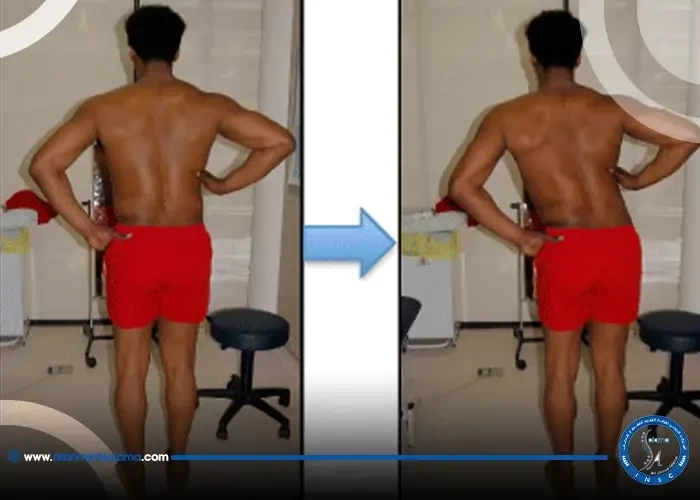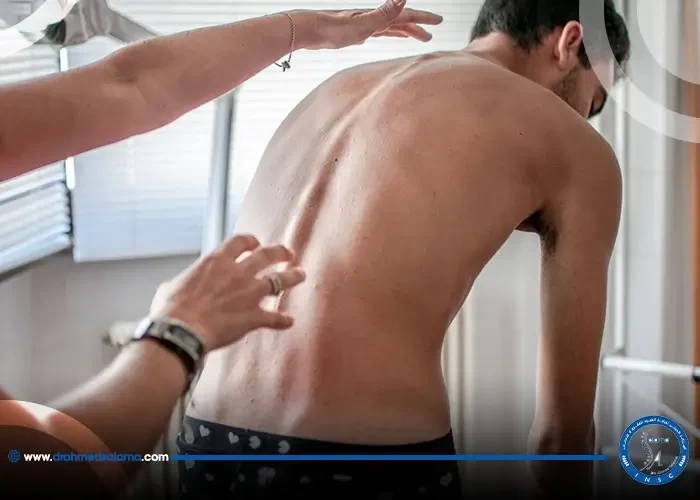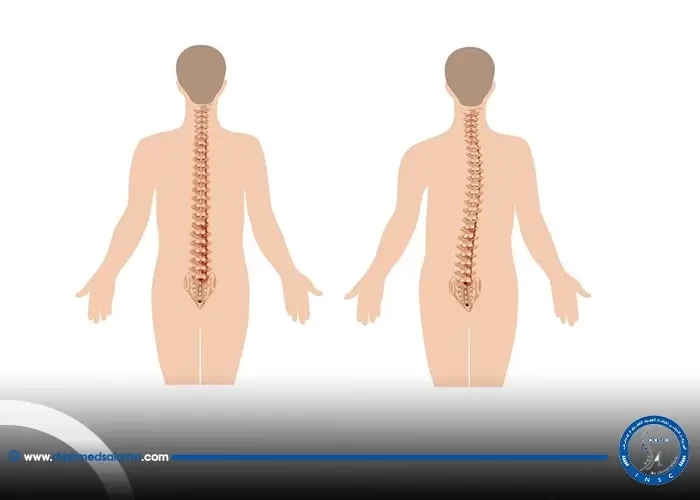Nasr City, 52 El Tayaran Street, in front of the Health Insurance Hospital

Scoliosis degrees

Scoliosis is a common health problem that can affect children, adolescents, and even adults. The severity of this health problem varies depending on the degree of spinal curvature. In some cases, it may simply require periodic follow-up, while others require specialized therapeutic or surgical intervention.
In this article, we review the degrees of spinal curvature, how each degree is diagnosed, and the importance of early detection of spinal curvature in children to achieve the best treatment outcomes. This article is presented by Dr. Ahmed Salama, a consultant neurosurgeon and spine surgeon. Salama has extensive experience in treating spinal curvature using the latest medical methods and the ability to develop a treatment plan that suits each individual case.
Grades of Scoliosis
Scoliosis is an abnormal lateral curvature that may develop gradually and affect the shape and function of the spine. The degree of spinal curvature is assessed by measuring the Cobb angle on an x-ray, which determines the degree of curvature and the appropriate treatment plan. Scoliosis is divided into the following degrees:
Mild scoliosis (10-25 degrees): A slight curve, often without obvious symptoms, and regular monitoring is sufficient.
Moderate scoliosis (25-40 degrees): A more pronounced curve accompanied by pain or shortness of breath, which may require a brace or therapeutic intervention.
Severe scoliosis (40-50 degrees): A severe curve that significantly impacts bodily functions and usually requires corrective surgery.
Severe scoliosis (over 50 degrees): A very severe curve that poses a threat to heart and lung function and requires urgent surgical intervention.
The danger of scoliosis lies in the fact that the condition often worsens over time if not treated early and accurately.
For an accurate diagnosis and a comprehensive treatment plan for scoliosis, you can book your consultation with Prof. Dr. Ahmed Salama, one of the pioneers of spine surgery in Egypt. Contact us now on 01011733393 to start your treatment journey safely and confidently. Learn more about scoliosis exercises.
Scoliosis Degrees
Scoliosis degrees vary significantly in severity and appearance. In mild cases, the curvature may be invisible or only slightly present, while in more severe cases, a pronounced curvature of the spine, whether in the neck or lower back, may appear, affecting balance. The exact shape and distribution of the curvature are determined through medical examinations such as x-rays. The degree of curvature varies from person to person depending on the type and cause of the condition.
Scoliosis Degrees: Classification, Causes, and Treatment
Scoliosis is a condition in which there is an abnormal curvature of the spine. It can range from mild to severe, significantly impacting bodily function. The classification of scoliosis degrees depends on its type and degree, and includes major types such as scoliosis, kyphosis, and scoliosis. In scoliosis, the spine curves sideways in an "S" or "C" shape, while in kyphosis, excessive curvature occurs at the top of the spine, resulting in a "corneal appearance." Scoliosis causes the spine to curve significantly to the side. The degree of curvature varies, ranging from a mild curvature (about 10 degrees) to more severe cases exceeding 40 degrees, requiring medical intervention. Mild forms of curvature can be treated with exercises and physical therapy, while severe cases require surgery or the use of braces
Learn about the degrees of scoliosis and how they affect your health
Scoliosis is a common problem that affects millions around the world. Its severity varies depending on the degree of curvature. The condition can range from a mild curvature that may not cause obvious symptoms to advanced forms that impact movement, breathing, and even quality of life. Understanding the degrees of scoliosis helps you detect the condition early and take appropriate measures to maintain your health. In this article, we will learn everything related to scoliosis degrees, their causes, and how to effectively manage them to ensure an active and healthy life free of pain and complications.
Causes of Scoliosis
The degrees of scoliosis are linked to several factors that vary depending on the type of scoliosis and the condition of each patient. The most prominent causes include:
Idiopathic scoliosis: This is the most common and often appears during puberty without a specific cause, although it may be related to genetic factors or cellular growth disorders.
Congenital scoliosis: This results from incomplete development of the vertebrae or their abnormal fusion from birth, leading to abnormal curvatures in the spine.
Neuromuscular scoliosis: This condition is associated with diseases affecting the muscles or nerves, such as cerebral palsy or muscular dystrophy. It usually develops rapidly and requires intensive treatment.
Other causes include spinal injuries, spinal cord tumors, or age-related degeneration of the vertebrae, such as degenerative scoliosis.
It's worth noting that scoliosis in the neck can lead to problems with head movement and persistent pain, while curvature of the lower back can impair your ability to walk and stand and increase the risk of chronic pain over time.
Don't let pain control your quality of life. Contact Dr. Ahmed Salama to discover the most appropriate treatment options for your condition. Book your consultation now and restore your quality of life. Also, follow up on scoliosis treatment.
What symptoms indicate a scoliosis?
Symptoms associated with spinal misalignment vary depending on the degree and type of curvature, but some signs may be a clear indicator of a problem. The most prominent symptoms associated with scoliosis include:
Uneven shoulders or one shoulder blade protruding from the other.
The body leans to one side, which can cause a feeling of imbalance.
The head is not positioned straight over the pelvis.
One side of the waist or thigh is higher than the other.
Skin changes along the back, such as deformity or discoloration.
A noticeable protrusion of the buttocks due to spinal curvature and protrusion of the buttocks, especially with lower back curvature.
Back or leg pain and difficulty standing up straight.
In cases of scoliosis in children, symptoms may go unnoticed. Therefore, it is recommended to undergo periodic examinations during growth to detect any abnormal curvature of the spine early.
Details about lumbar spinal canal dilation
What are the harms of scoliosis?
The effects of scoliosis are not limited to physical aspects only; they also extend to affect psychological health. The most prominent of these effects are:
Chronic pain: Patients suffer from persistent pain extending from the neck to the upper buttocks, especially with the development of scoliosis and protruding buttocks.
Difficulty standing upright: The body leans to one side, making it difficult to maintain a proper posture.
Structural deformities: Such as uneven shoulders, a tilted head, or one hip being higher than the other.
Loss of mobility: Due to weak core muscles, numbness or pain in the legs.
Psychological effects: Such as decreased self-confidence, social isolation, and anxiety or depression, especially in children with scoliosis.
Learn about endoscopic hand nerve decompression.
What are the four natural curves of the spine?
The spine has four natural curves that help support the body and distribute weight evenly, protecting against the development of problems such as scoliosis or related problems such as scoliosis and pregnancy. These curves include:
Neck lordosis (cervical lordosis): A slight inward curve that supports the head and maintains balance.
Mid-back lordosis (thoracic lordosis): A natural outward curve that helps protect the heart and lungs.
Lumbar lordosis (lumbar lordosis): An inward curve that helps absorb shock and support the upper body.
Sacral lordosis (coccygeal lordosis): A small outward curve in the pelvic region that helps support weight while sitting and standing.
These curves play an important role in determining the degree of scoliosis when any abnormality or deviation occurs.
If you are experiencing back pain or feel a curvature in your spine, do not hesitate to consult Dr. Ahmed Salama for an accurate diagnosis and a personalized treatment plan. Call now to schedule a consultation.
Also learn about failed spinal fusion surgery.
How is scoliosis treated?
Treatment methods depend on the type and degree of curvature, as well as the patient's age and overall condition of the spine. Basic treatment options include:
Drug therapy
This treatment is primarily used in mild cases of scoliosis to relieve pain, using nonsteroidal anti-inflammatory drugs (NSAIDs) or analgesics, especially in cases of symptoms such as scoliosis, bulging buttocks, or lower back pain.
Exercise
Gentle exercise and physical therapy programs help strengthen muscles, improve flexibility, and help alleviate complications of scoliosis in the neck and lower back. However, they do not completely correct the curvature.
Brace Treatment
Back braces are used for scoliosis in children during growth periods to stabilize the spine and prevent further curvature. They may also relieve pain in adults in some cases.
Injection Therapy
Spinal injections provide a temporary solution to relieve inflammation and nerve pressure caused by the scoliosis, but they are not considered a permanent cure.
Surgical Intervention
Surgery is recommended when conservative measures fail or when scoliosis has progressed significantly, especially in cases associated with complications such as chronic pain or nerve compression. Surgical procedures vary from stabilizing the vertebrae with metal braces to using expandable rods, especially if the curvature worsens during rapid growth periods.
In all cases, treatment aims to improve spinal alignment, reduce pain, and prevent future progression.
Scoliosis and Pregnancy
Although scoliosis does not directly affect fertility or the ability to conceive, pregnancy can pose additional challenges for a woman with this condition. With weight gain and the pressure of pregnancy on the spine, symptoms such as back pain or difficulty maintaining balance may appear, especially in the later stages of pregnancy.
In cases where the curvature is severe, the patient may feel greater impacts on their comfort during pregnancy. Therefore, it is essential to consult with specialists like Dr. Ahmed Salama to ensure accurate health monitoring and provide appropriate advice for maintaining comfort and relaxation during pregnancy. For more information about the cost of scoliosis surgery in Egypt, please visit:
The Best Doctor for Treating Different Degrees of Scoliosis
Dr. Ahmed Salama is one of the most prominent doctors specializing in treating various degrees of scoliosis, whether mild or severe. He has extensive experience and advanced treatment techniques that guarantee effective and safe results for patients. Thanks to his high skill, he has become a preferred choice for many patients seeking to restore their spinal health. Dr. Ahmed Salama's advantages include:
Extensive experience in neurosurgery and spine surgery.
Using the latest diagnostic and treatment techniques.
Highly skilled in correcting spinal deformities with minimal surgical intervention.
Close monitoring of the patient's condition before and after treatment to ensure complete recovery.
Excellent ability to work with various age groups, from children to the elderly.
Ensuring personalized treatment plans tailored to each patient's individual condition.
In conclusion, the degree of scoliosis varies from case to case, requiring accurate diagnosis and tailored treatment based on the severity of the condition. It is important to follow up with specialized physicians like Dr. Ahmed Salama to ensure effective treatment and prevent future complications. Early attention and adherence to treatment significantly contribute to improving quality of life and reducing the effects of scoliosis on overall health.
How do I know the degree of scoliosis?
The degree of spinal curvature can be determined through a comprehensive medical examination using X-rays or specialized tests. This helps determine the extent of spinal curvature and assess its impact on the patient's health.
Is it possible to live with scoliosis?
Yes, it's possible to live with scoliosis in many cases, especially if the scoliosis is mild. With appropriate treatment, such as exercises or surgery in severe cases, quality of life can be improved and associated symptoms reduced.






